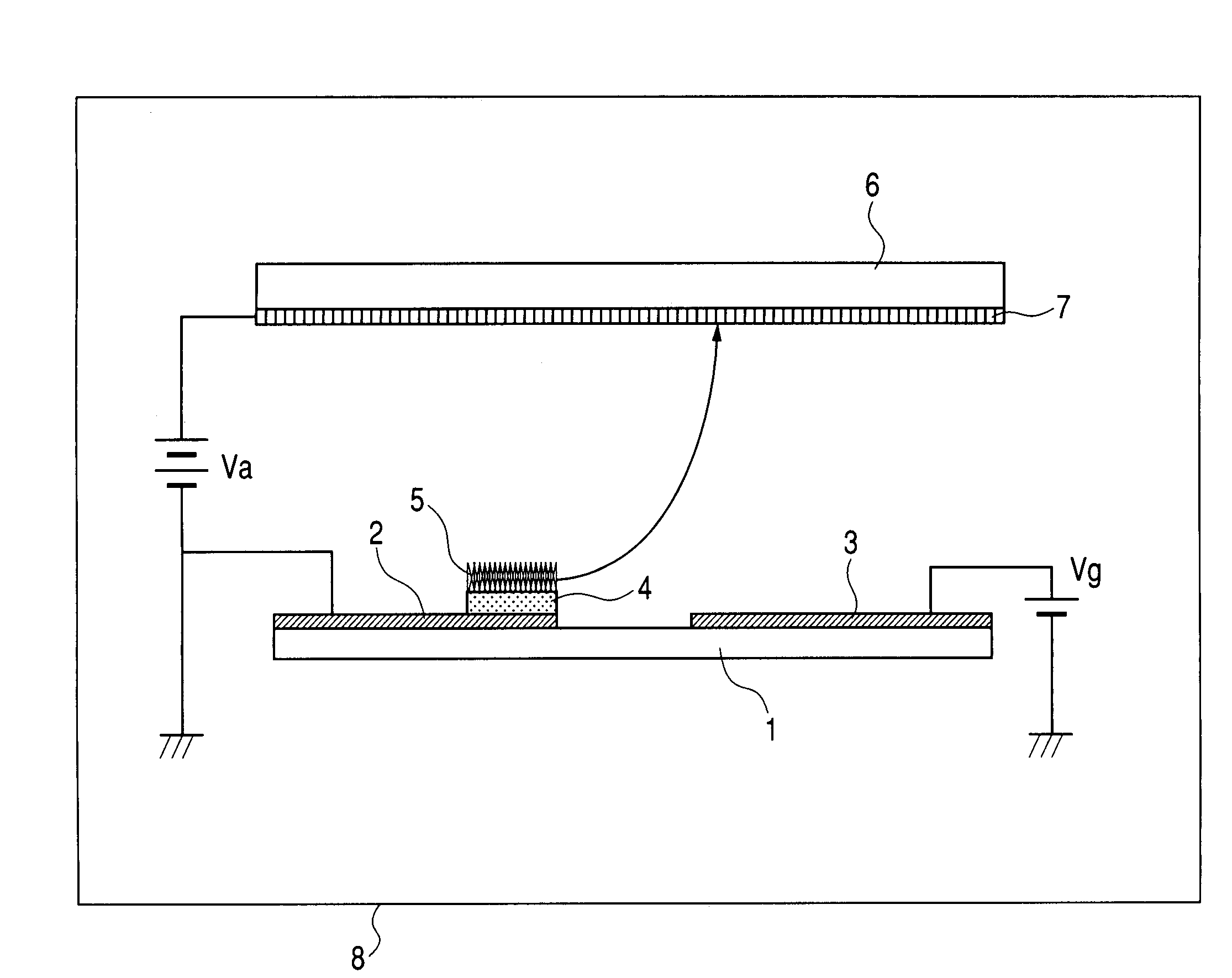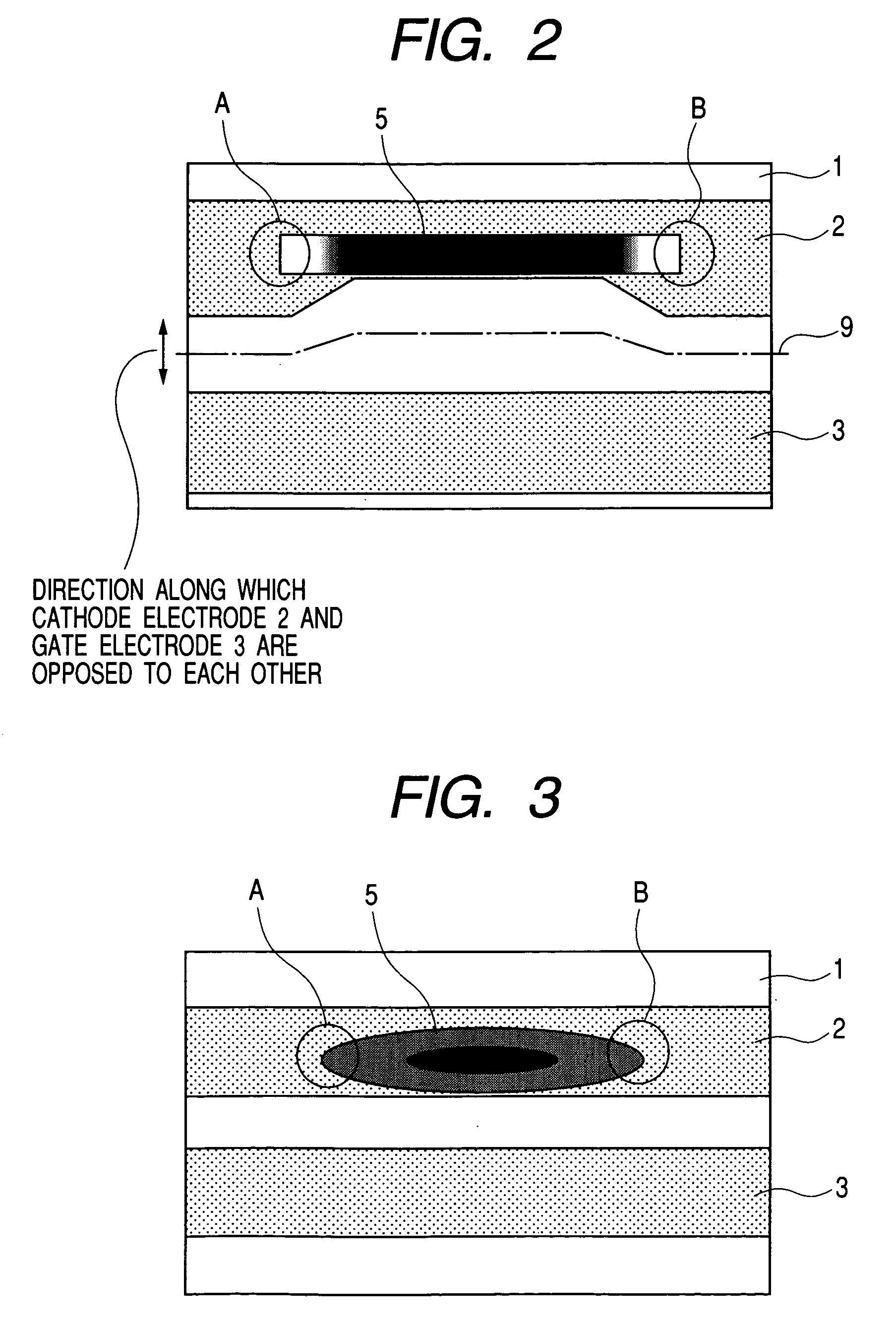Electron-emitting device, electron source, and image display apparatus
- Summary
- Abstract
- Description
- Claims
- Application Information
AI Technical Summary
Benefits of technology
Problems solved by technology
Method used
Image
Examples
example 1
[0107]FIG. 2 shows the electron-emitting device according to Example 1 when it is viewed from above the base surface.
[0108]In FIG. 2, reference numeral 1 denotes the substrate; 2, the cathode electrode; 3, the gate electrode; and 5, the electron-emitting film. Note that the conductive layer 4 (not shown) is inserted between the cathode electrode 2 and the electron-emitting film 5, and a combination of the cathode electrode 2 and the conductive layer 4 is called the cathode electrode.
[0109]Here, quartz is used for the substrate 1, Pt is used for the cathode electrode 2 and the gate electrode 3, a graphite nanofiber is used for the electron-emitting film 5, and TiN is used for the conductive layer 4.
[0110]Also, according to the structure shown in FIG. 2, the conductive layer 4 and the electron-emitting film 5 are formed in substantially the same region. However, the conductive layer 4 may be formed so as to include a formation region of the electron-emitting film 5.
[0111]The electron-...
example 2
[0124]FIG. 3 shows the electron-emitting device according to Example 2 when it is viewed from above the base surface. The electron-emitting device according to this example can be manufactured by the same method as for the electron-emitting device described in Example 1. In addition, the same references are provided to the same members as in Example 1.
[0125]In the electron-emitting device according to this example, the space between the gate electrode 3 and the cathode electrode 2 is constant. The electron-emitting film 5 was elliptically patterned and the substantially two end portions A and B exist in a direction along a gap between the gate electrode 3 and the cathode electrode 2.
[0126]As is apparent from FIG. 3, the distance between the end of the cathode electrode 2 and the electron-emitting film 5 is relatively large in each of the end portions A and B. On the other hand, in the region between the end portions A and B, the end of the cathode electrode 2 is close to the end of ...
example 3
[0130]FIG. 4 shows the electron-emitting device according to Example 3 when it is viewed from above the base surface. The electron-emitting device according to this example can be manufactured by the same method as for the electron-emitting device described in Example 1. In addition, the same references are provided to the same members as in Example 1.
[0131]The electron-emitting film 5 was patterned in a strip shape with a predetermined width. Therefore, the two end portions A and B exist in the longitudinal direction of the electron-emitting film 5.
[0132]The cathode electrode 2 protrudes more to the gate electrode 3 side in areas between each of the two end portions A and B of the electron-emitting film 5 and the gate electrode 3, as compared with an area between the region located between the two end portions of the electron-emitting film 5 and the gate electrode 3.
[0133]Thus, the space between the gate electrode 3 and the cathode electrode 2 is not constant but is wider in the re...
PUM
 Login to View More
Login to View More Abstract
Description
Claims
Application Information
 Login to View More
Login to View More - R&D
- Intellectual Property
- Life Sciences
- Materials
- Tech Scout
- Unparalleled Data Quality
- Higher Quality Content
- 60% Fewer Hallucinations
Browse by: Latest US Patents, China's latest patents, Technical Efficacy Thesaurus, Application Domain, Technology Topic, Popular Technical Reports.
© 2025 PatSnap. All rights reserved.Legal|Privacy policy|Modern Slavery Act Transparency Statement|Sitemap|About US| Contact US: help@patsnap.com



